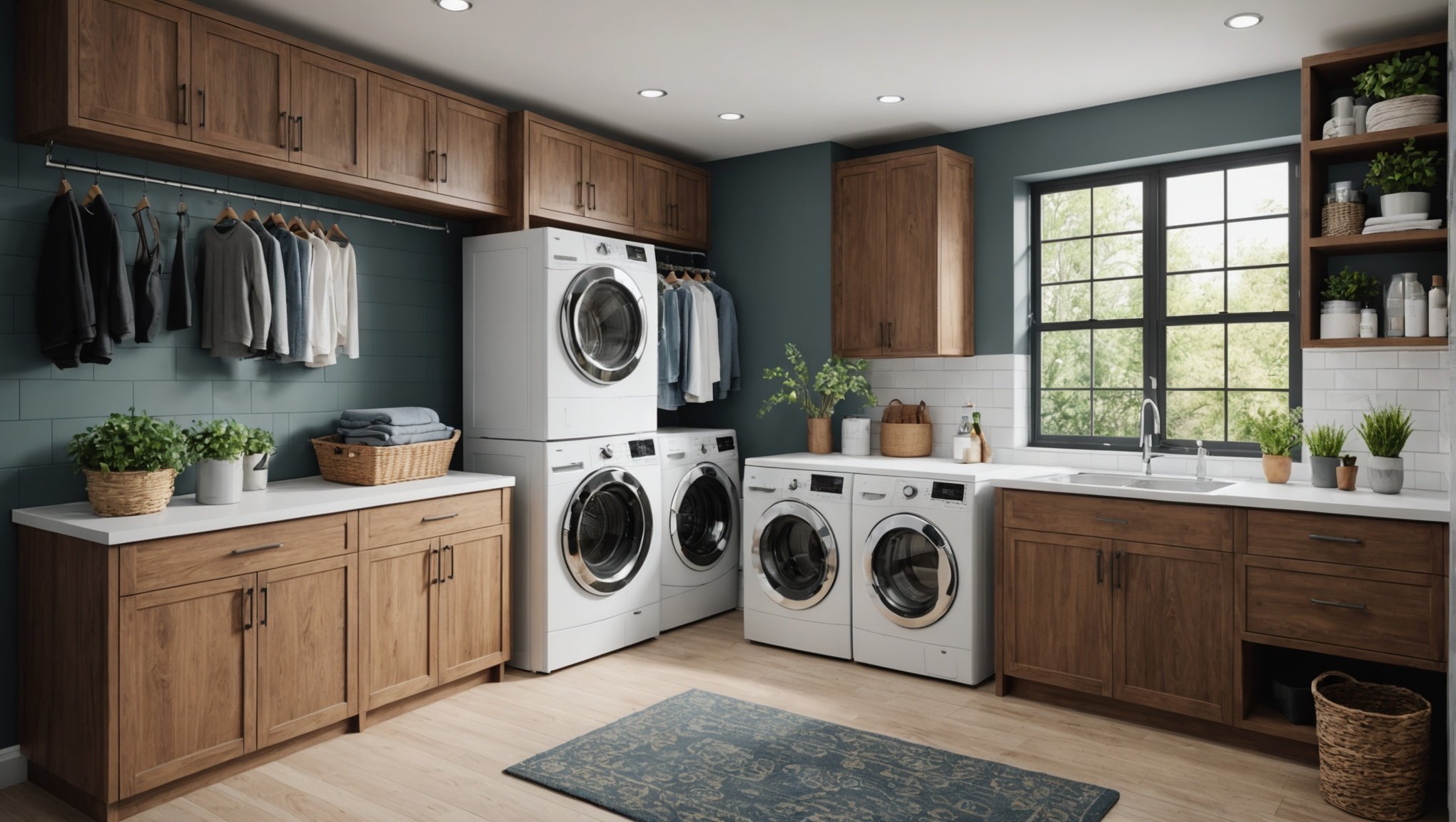Understanding Eco-Friendly Laundry Design
Eco-friendly laundry design combines sustainability with effective space optimization to create a harmonious and efficient household area. The importance of sustainability cannot be overstated; it now permeates every aspect of home design, including laundry rooms. Integrating sustainable practices involves selecting eco-friendly materials, like bamboo cabinets or recycled countertops, that reduce environmental impact.
Adopting eco-friendly materials also means choosing energy-efficient appliances. Front-loading washing machines and dryers, for instance, use less water and energy, aligning with sustainable goals. Additionally, sustainable practices advocate for organic detergents that minimise harmful chemicals entering water systems. These small changes contribute significantly to a greener planet.
Also read : Effortless Aquarium Design: Create a Self-Sustaining Underwater Oasis for the Busy Homeowner
Space optimization plays a pivotal role in enhancing both functionality and aesthetics. An organized laundry area maximizes efficiency, making chores less daunting and time-consuming. Tall shelving units, wall-mounted drying racks, and storage bins ensure everything has its place, promoting a clutter-free environment. An efficient layout allows for easy access to essentials while conserving space.
The benefits of such design choices are extensive. Not only do they reduce the ecological footprint, but they also enhance daily living through practicality and orderliness. Embracing eco-friendly laundry design is a step toward sustainable living and a more enjoyable home environment.
Also to see : Creating the Perfect Backyard Succulent Oasis: Optimal Conditions for Dry Climates
Choosing Advanced Appliances
Exploring advanced appliances can greatly enhance the functionality and efficiency of your home. The integration of smart appliances into daily routines offers not only convenience but also promotes environmental responsibility.
Energy-Efficient Washers
Modern energy-efficient washers drastically reduce energy and water consumption. These machines use innovative sustainable technology to adjust water levels based on load sizes, which minimizes waste. Additionally, features such as cold-water washes and high-efficiency spin cycles further contribute to reducing your carbon footprint. By choosing these models, consumers can significantly lessen their environmental impact, while also enjoying lower utility bills.
Smart Dryers
Smart dryers offer a host of features designed to enhance user experience while maintaining energy efficiency. Many models come equipped with sensors that optimize drying time, preventing unnecessary energy usage and wear on clothing. Integration with mobile apps allows for remote monitoring and control, enabling users to manage loads efficiently from anywhere. This smart technology, combined with quick-dry and eco-friendly options, provides both practicality and sustainability.
Eco-Friendly Detergents
Selecting the right detergent is crucial for both laundry effectiveness and environmental impact. Eco-friendly detergents are formulated to work efficiently in energy-saving washing machines, using biodegradable ingredients that minimize pollution. When choosing detergents, consider the reduction of harsh chemicals, concentrated formulations, and suitability for cold-water washing. Such practices align with a broader commitment to sustainability and health.
Layout Ideas for Sustainability
Designing a sustainable laundry room starts with effective space planning. Prioritise layouts that maximise floor space, allowing for better airflow and reduced energy use. Position appliances like washers and dryers side by side to create a continuous workspace. This not only enhances ergonomic design by reducing movement but also centralises the workflow, improving efficiency.
Integrating storage solutions is crucial for keeping eco-friendly products organised and accessible. Consider installing vertical shelving units. These can store environmentally friendly detergents and other supplies, promoting a clutter-free environment. Use clear glass jars or containers for eco-friendly detergents, making it easy to identify contents while reducing plastic use.
Attention to ergonomic design ensures the laundry room is comfortable and efficient for all users. Ensure countertops are at a height that eliminates the need for excessive bending. Installing pull-out shelves can prevent strain by making accessing essentials more straightforward. Adjustable shelves can accommodate various product sizes, making them a staple for any sustainable laundry room.
These layout strategies not only foster an eco-conscious approach but also enhance utility. With a focus on practical space utilisation, long-term sustainability becomes a realistic goal. Embrace these ideas to blend style with environmental responsibility in your laundry room.
Implementing Energy-Saving Practices
Implementing energy-saving practices can significantly reduce both environmental impact and utility bills. By focusing on water conservation and efficient drying techniques, individuals can adopt a more sustainable lifestyle.
Water Conservation Strategies
Water conservation is crucial for reducing waste and conserving this valuable resource. Start by fixing leaks, as even small drips can lead to significant water loss. Additionally, installing low-flow faucets and showerheads can cut water usage without sacrificing performance. For outdoor spaces, collect rainwater for garden irrigation and opt for drought-resistant plants. These strategies not only conserve water but also reduce utility costs.
Efficient Drying Methods
Adopting efficient drying methods can further enhance energy conservation efforts. Instead of relying solely on electric dryers, consider air drying clothes. Hanging moisture-laden garments on a clothesline not only saves energy but also prolongs the lifespan of your fabrics. Air drying is especially effective in warmer months, allowing natural airflow and warmth to facilitate the process.
Utilizing Sunlight
Harnessing natural light is an underrated drying technique that offers considerable energy savings. Position clotheslines or drying racks in sunlit areas to maximize efficiency. Sunlight not only aids in the drying process but also acts as a natural disinfectant. By utilizing these energy-saving tips, you can make a noticeable impact on your household’s energy consumption.
Benefits of Smart Technology in Laundry
Smart technology in laundry is revolutionising the way households manage their chores. With smart home integration, appliances are now more efficient and user-friendly. Through this integration, users can leverage features like remote control to manage their laundry from anywhere. Picture this: you can start your washing cycle with a simple tap on your smartphone while enjoying a day out.
Monitoring systems play a vital role in energy and water conservation. These systems provide real-time data, allowing users to track usage and optimise their settings. For example, a smart washer can adjust water levels based on the load size, minimising waste.
Connecting laundry spaces with home automation elevates convenience. Imagine receiving notifications when your laundry is done, eliminating guesswork. Smart machines can even schedule themselves to run during off-peak energy hours, saving money. Additionally, voice assistants integrated into your home system can receive commands to start, stop, or schedule washes, making the process hands-free.
With these advancements, smart technology not only simplifies tasks but also promotes eco-friendly living and cost efficiency. Embracing such innovations means less time worrying about laundry and more time enjoying life’s other pleasures.











